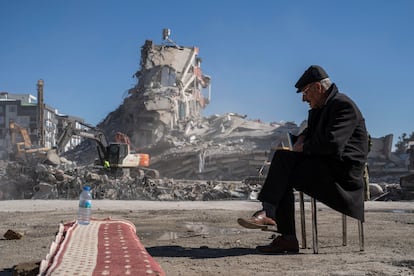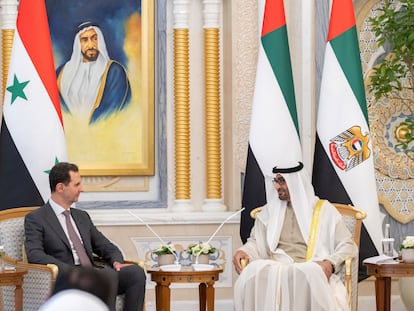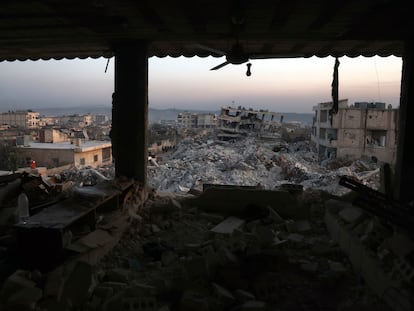Turkey rushes to rebuild an area larger than Portugal after the earthquake
President Erdoğan has pledged to build half a million homes within a year, but experts and the opposition say this promise is due to upcoming elections in May


A month and a half after the earthquake that rocked southeastern Turkey and northwestern Syria and killed nearly 60,000 people, bulldozers are still removing rubble and demolishing buildings. The task is daunting: it adds up to around 200 million tons of concrete, brick, metal and wood, according to calculations by the United Nations Development Program (UNDP). In terms of volume, this debris, piled one meter high, would occupy 100 square kilometers (38.6 square miles), similar in size to the city of Barcelona and much larger than Manhattan.
Around 3.3 million people have been displaced by the earthquake in Turkey alone. Many have gone to the western provinces, where they are staying with relatives, in hotels that have opened their doors to them, or at university dorms. But almost two million, according to data from the Turkish government, are living in camps for victims in the region where the earthquake hit, and where, in addition, last week’s storms caused flooding and 20 deaths.
More than 500,000 homes have been destroyed by the earthquake or must be demolished due to serious structural damage. Another 130,000 have sustained moderate damage and cannot be inhabited until extensive repair work gets done. Likewise, tens of thousands of public buildings ― from schools and hospitals to government offices ― have sustained severe damage, as has private property ranging from stables and farms to factories. But there is also damage to key infrastructure such as roads, airports, ports, railways, power lines and reservoirs. More than 620 miles of pipes carrying drinking water and around 1,200 miles of sewers have been damaged, as well as several sewage and wastewater treatment plants.
“The magnitude of the destruction is tremendous. On the road from Nurdag to Antakya [along the fault line in southeastern Anatolia] the only thing that changes about the buildings is whether they are badly damaged or if they are razed to the ground. The size of the affected area is 110,000 square kilometers ― larger than Austria or Portugal, and similar to Bulgaria ― which creates a very big problem. It is not like in other places we have been, where you can concentrate the reconstruction work,” explains Humberto López, director of the World Bank for Turkey, who was recently in the area to analyze the situation. The first damage assessment by the World Bank established the direct impact of the earthquake at $34 billion, to which must be added a similar amount for reconstruction. And then there are the losses associated with the interruption of economic activity in the area, which the institution estimates at around $4 billion.
These estimates are lower than those made by the UNDP (more than $100 billion) and by the Turkish government, which placed the cost of the earthquake at $103.6 billion or around 10% of the country’s GDP. The Turkish opposition, which is pinning its hopes on the upcoming May elections, believes that the figure will be even higher, along the lines of $126 billion. López explains why there is such a disparity in the figures: “In these calculations we must distinguish between the damage suffered by affected infrastructure, which is what we have calculated, and the cost of undoing the effects of that damage, which is more difficult to calculate because it depends on how the reconstruction is carried out. Our data suggests that half of the damage has been to privately owned residential buildings. And we still do not know how that reconstruction will be carried out, whether it will be done through public initiative, subsidies and so on.”
Despite this, a European source involved in the earthquake damage analysis says that the impact is much greater: “The evaluation has not yet been completed in many aspects. A more detailed analysis of the impact is needed not only on buildings, but also on people. And the cost of reconstruction will be even higher, because it cannot be rebuilt the same way as before.”
The government of Recep Tayyip Erdoğan has promised to build half a million homes within a year. Part of these will be built by the public agency TOKI and part through semi-open tenders that private companies will bid for. And there are areas of towns that will have to be moved because, as past earthquakes have shown, the ground where they were located will not resist new powerful tremors, no matter how well it is built up. “During the earthquake the ground behaved as if it were liquid and the buildings lost all support, so our technicians explain that, in these areas, it will not be possible to rebuild,” says López.
In some localities, the foundations of new urban areas have already begun to be excavated after Erdoğan passed a decree, something that the Union of Turkish Chambers of Architects and Engineers (TMMOB) considers premature, because it is being done without a new zoning plan. In addition, Eyüp Muhçu, president of the Turkish Chamber of Architects, explains that it is not yet safe to start building, since the constant aftershocks in the region could damage the foundations while the cement sets. “It is being built in a hurry out of pure election concerns, just to be able to say before the [May] elections: ‘We have already built this many buildings, and we will finish within a year,’” says Muhçu. “Instead, decent living conditions should be guaranteed at the temporary settlements because earthquake victims are likely to spend two or three years there. But no attention is being paid to that. There are just a few containers and prefabricated houses. Most of the people live in tents, in poor conditions, and there could be problems like we had with the recent floods.”
On Monday, at the International Donors’ Conference in Brussels, Turkish Foreign Minister Mevlüt Çavuşoğlu stated that Turkey will build “faster, better and greener,” but experts stress the need to focus on quality rather than speed, taking into account that Turkey sits on an area of intense seismic activity.
In Brussels, donors pledged around €6 billion ($6.5 billion) in aid and soft loans for the reconstruction of Turkey, an amount far less than necessary, although it could be increased in the future. “I am sure that, in the coming years, the international community will offer more money according to the needs. The bottleneck will not be money, but the reconstruction projects,” says the European source with knowledge of the matter, noting that housing needs are five or six times greater than the annual construction capacity of the sector in Turkey. Each donor country or institution will choose how the funds are distributed; in the case of the European donors they will go to specific projects, which will be monitored technically and financially: “It is important for donors that the projects meet a series of requirements. And we also have to justify every penny of European taxpayers’ money.”
Sign up for our weekly newsletter to get more English-language news coverage from EL PAÍS USA Edition
Tu suscripción se está usando en otro dispositivo
¿Quieres añadir otro usuario a tu suscripción?
Si continúas leyendo en este dispositivo, no se podrá leer en el otro.
FlechaTu suscripción se está usando en otro dispositivo y solo puedes acceder a EL PAÍS desde un dispositivo a la vez.
Si quieres compartir tu cuenta, cambia tu suscripción a la modalidad Premium, así podrás añadir otro usuario. Cada uno accederá con su propia cuenta de email, lo que os permitirá personalizar vuestra experiencia en EL PAÍS.
¿Tienes una suscripción de empresa? Accede aquí para contratar más cuentas.
En el caso de no saber quién está usando tu cuenta, te recomendamos cambiar tu contraseña aquí.
Si decides continuar compartiendo tu cuenta, este mensaje se mostrará en tu dispositivo y en el de la otra persona que está usando tu cuenta de forma indefinida, afectando a tu experiencia de lectura. Puedes consultar aquí los términos y condiciones de la suscripción digital.
More information
Archived In
Últimas noticias
There is as much life left to discover on planet Earth as that which is already known
Dozens presumed dead, around 100 injured in fire at Swiss Alps bar during New Year’s celebration
Is porn for women different from conventional porn? We spoke to those who make it
Cartagena de Indias is sinking: What can the city do to mitigate it?
Most viewed
- Reinhard Genzel, Nobel laureate in physics: ‘One-minute videos will never give you the truth’
- David King, chemist: ‘There are scientists studying how to cool the planet; nobody should stop these experiments from happening’
- Oona Chaplin: ‘I told James Cameron that I was living in a treehouse and starting a permaculture project with a friend’
- Sinaloa Cartel war is taking its toll on Los Chapitos
- The Interoceanic Train, the Mexican alternative to the Panama Canal










































